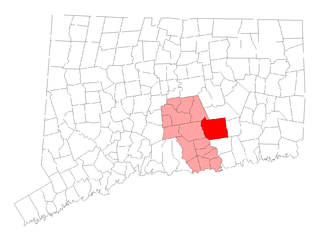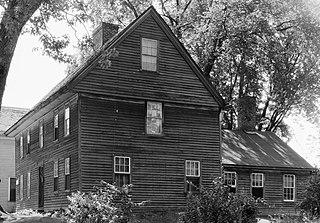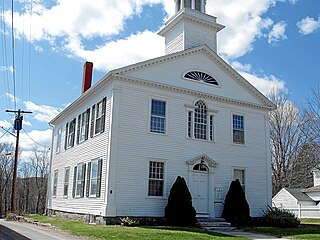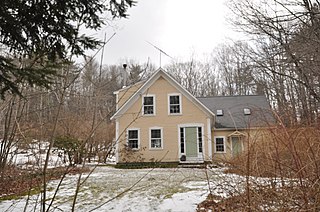
East Haddam is a town in Middlesex County, Connecticut, United States. The population was 8,875 at the 2020 census.

Moodus is a village in the town of East Haddam, Connecticut, United States. The village is the basis of a census-designated place (CDP) of the same name. The population of the CDP was 1,413 according to the census of 2010.

The Buttolph–Williams House is a historic house museum at 249 Broad Street in Wethersfield, Connecticut. Built in 1711, it is one of the oldest surviving houses in the town. It is owned by Connecticut Landmarks, a historic preservation organization, and is open for regular tours between May and October. it was designated a National Historic Landmark in 1968 for its significance as an extremely well-preserved example of early colonial architecture.

The Prudence Crandall Museum is a historic house museum, sometimes called the Elisha Payne House for its previous owner. It is located on the southwest corner of the junction of Connecticut Routes 14 and 169, on the Canterbury, Connecticut village green. It is designated a U.S. National Historic Landmark as Prudence Crandall House.

The Whitaker-Clary House is a historic house in New Salem, Massachusetts, United States. It currently houses the museum of the Swift River Historical Society. Built about 1816, it is a fine local example of Federal period architecture, and was listed on the National Register of Historic Places in 1975.

The Old Tolland County Courthouse is a historic former courthouse at 53 Tolland Green in Tolland, Connecticut. Built in 1822 it was used as a county courthouse until the 1890s. It housed the Tolland Public Library from 1899 to 1985. Now a history museum operated by the Tolland Historical Society, the building was listed on the National Register of Historic Places in 1977.

The Carpenter House, also known as the Gardiner (Gardner) Carpenter House and the Red House, is a Georgian style house in Norwichtown area of Norwich, Connecticut. A house was previously on the site, but it was removed by Gardner Carpenter to construct the house in 1793. The three-story Flemish bond Georgian house's front facade consists of five bays with a gabled porch over the main entrance and supported by round columns. The gambrel roof and third story addition were added around 1816 by Joseph Huntington. In 1958, a modern one-story rear wing was added to the back of the house. The interior of the house is a center hall plan with 10-foot (3.0 m) high ceilings and has been renovated, but retains much of its original molding, paneling and wrought iron hardware. It was listed on the National Register of Historic Places in 1970 and added to the Norwichtown Historic District in 1973.

The South Canaan Congregational Church is a historic Congregational church building at Connecticut Route 63 and Barnes Road in the town of Canaan, Connecticut. Built in 1804, it is a remarkably well-preserved example of early Federal period church architecture. It was listed on the National Register of Historic Places in 1983.

The Centerbrook Congregational Church, also known as the Centerbrook Meeting House, is a historic church at 51 Main Street in the Centerbrook village of Essex, Connecticut. It is a single-story wood-frame structure resting on a granite foundation, which is set on a knoll on the north side of Connecticut Route 153. The main block was built in 1790, making it the oldest known church in Middlesex County and one of the oldest in the entire state. The building added to the National Register of Historic Places in 1987.

The Bellamy-Ferriday House and Garden is a historic house museum at 9 Main Street North in Bethlehem, Connecticut. The main house was built between about 1754 and 1767 by the Rev. Joseph Bellamy, a prominent Congregationalist minister who played an influential role in the First Great Awakening. The property, the National Register of Historic Places in 1982. The house and surrounding gardens are owned and operated by Connecticut Landmarks; admission is charged. Another 81 acres of forest and fields adjacent to the museum property are maintained as Bellamy Preserve, the town of Bethlehem's "Central Park," by the Bethlehem Land Trust.

The Henry Champion House is a historic house on Westchester Road in Colchester, Connecticut. Built in 1790, it is a good local example of Federal period architecture, designed by William Sprat, a prominent early architect. It was built by Colonel Henry Champion, a veteran of the American Revolutionary War for his son, also named Henry. The house was listed on the National Register of Historic Places in 1972.

The Hayward House is a historic house at 9 Hayward Avenue in Colchester, Connecticut. Built in 1775 and embellished in the late 19th century, it is a well-preserved 18th-century house, which has seen a number of locally prominent residents, as well as the nationally known inventor Nathaniel Hayward, who developed the process of vulcanizing rubber. The house was listed on the National Register of Historic Places in 1972.

The Butler-McCook Homestead is a historic house museum at 396 Main Street in Hartford, Connecticut. Built in 1782, it is one of the city's few surviving 18th-century houses. It was listed on the National Register of Historic Places in 1971. It is now operated as the Butler-McCook House & Garden by Connecticut Landmarks.

The James Hazelton House, also known as the Hazelton-Hayden House, is a historic house at 23 Hayden Hill Road in Haddam, Connecticut. With a construction history dating to about 1720, it is one of the town's oldest buildings, with a long history of ownership by a single prominent local family. The house was listed on the National Register of Historic Places in 1988, and is a contributing property in the Haddam Center Historic District.

The Warner House is a historic house at 307 Town Street in East Haddam, Connecticut. Built roughly in the mid-18th century, it is notable for its high quality interior woodwork and hardware, the latter of which were probably made by some of its owners. The house was listed on the National Register of Historic Places in 1987. The house is now owned by Connecticut Landmarks, which is in 2018 preparing to open it as a historic house museum.

Connecticut Landmarks is a non-profit organization that has restored and operates significant historic house museums in Connecticut. Headquartered in Hartford, Connecticut, the organization was founded in 1936 as the Antiquarian & Landmarks Society. Connecticut Landmarks currently owns a statewide network of historic properties that span four centuries of history. The organization's mission is to "use historic properties to inspire an understanding of our complex past. The organization's vision is to have "A state whose understanding of its diverse past inspires its people to move forward together as one." The organization is part of the International Coalition of Sites of Conscience.

The Jabez Townsend House is a historic house at the southwest corner of Hancock and Cherry Hill Roads in Harrisville, New Hampshire. Built in 1853, it is a good local example of a rural Greek Revival farmhouse. The house was listed on the National Register of Historic Places in 1988.

Johnsonville Village, once a thriving mill community, then a Victorian Era tourist attraction, was an abandoned ghost town in East Haddam, Connecticut, United States. On July 7, 2017, the property was acquired by the Iglesia ni Cristo, an independent, nontrinitarian Christian denomination based in the Philippines.

The Edward Frisbie Homestead is a historic house at 240 Stony Creek Road in Branford, Connecticut, United States. Built about 1790 by the grandson of one of Branford's first settlers, it is a little-altered and well-preserved example of Federal period architecture. It was listed on the National Register of Historic Places in 1985.

The Rising Sun Tavern is a historic house and former public accommodation on Old Tavern Road in North Haven, Connecticut. Probably built around 1760, it is a well-preserved example of an 18th-century tavern house, serving in that role into the mid-19th century. Now a private residence, it was listed on the National Register of Historic Places in 1979.






















